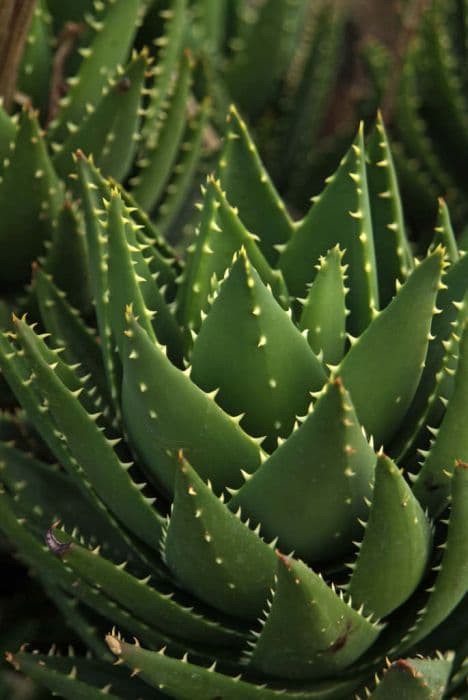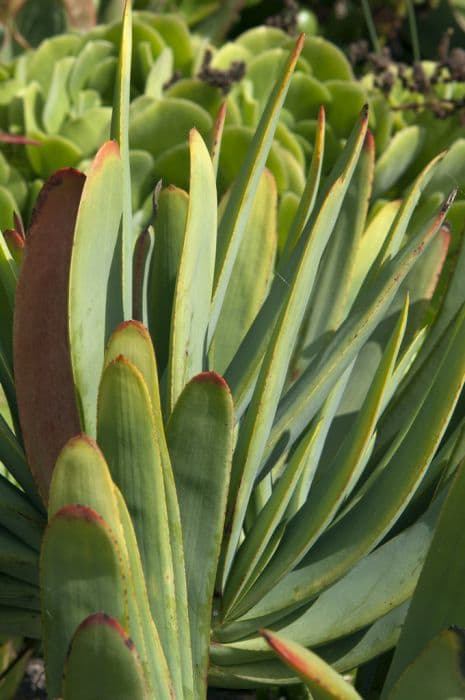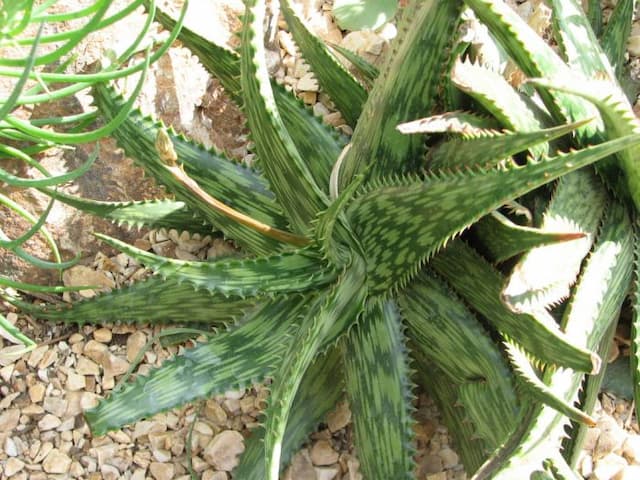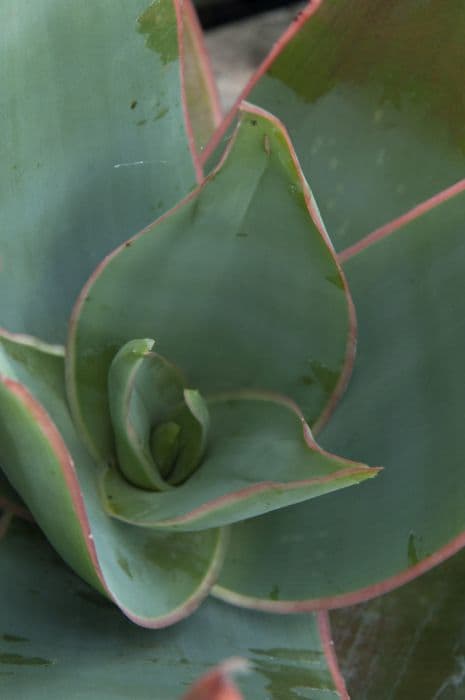Red Hot Poker Kniphofia 'Bees' Lemon'

ABOUT
The Kniphofia 'Bees' Lemon', commonly known as Red Hot Poker or Torch Lily, is a striking flowering perennial known for its unique and eye-catching blooms. The flower spikes arise from a dense clump of slender, grass-like foliage that is deep green in color. The signature feature of this plant is its flower spikes, which boast tubular florets. These florets are characterized by their gradient hues, starting with a lemony yellow at the tip, transitioning into a paler yellow, and sometimes becoming a greenish shade toward the base. The flowers are densely packed on the tall, upright spikes, giving the impression of a flaming torch, which is where the common names are derived from. The vivid flower spikes create a dramatic display and are a magnet for pollinators, such as bees and hummingbirds. The flowers bloom progressively from the bottom up, extending the show of color through the blooming season. The foliage of the Kniphofia 'Bees' Lemon' remains attractive throughout the growing season, providing a lush backdrop for the bright blooms. With its distinct flowers and foliage, the plant adds texture and a burst of warm colors to any garden setting, especially when planted in groups.
About this plant
 Names
NamesFamily
Asphodelaceae
Synonyms
Red Hot Poker, Torch Lily, Poker Plant
Common names
Kniphofia 'Bees' Lemon'
 Toxicity
ToxicityTo humans
Red hot poker plants, including the 'Bees' Lemon' variety, are generally considered to have low toxicity to humans. They are not known for causing serious harm if accidentally ingested. However, as with many plants, individual sensitivity varies, and eating parts of the plant could potentially cause mild stomach upset or an allergic reaction in some people. Seek medical attention if any unusual symptoms occur after handling or ingesting parts of the plant.
To pets
Red hot poker plants, which include the 'Bees' Lemon' variety, are typically not listed as highly toxic to pets. However, it can vary between individual animals, and ingestion could potentially result in gastrointestinal discomfort like vomiting or diarrhea. If you suspect your pet has eaten any part of a red hot poker plant and is showing adverse symptoms, it is advisable to consult a veterinarian.
 Characteristics
CharacteristicsLife cycle
Perennials
Foliage type
Evergreen
Color of leaves
Green
Flower color
Yellow
Height
2-3 feet (0.6-0.9 meters)
Spread
1-2 feet (0.3-0.6 meters)
Plant type
Herb
Hardiness zones
6
Native area
South Africa
Benefits
 General Benefits
General Benefits- Attracts Pollinators: Red Hot Poker draws in bees, butterflies, and hummingbirds, which help with pollination and enhances biodiversity in the garden.
- Drought Tolerant: Once established, it can withstand periods of low water, making it suitable for xeriscaping or drought-prone regions.
- Low Maintenance: It requires minimal care, making it an excellent choice for gardeners who prefer plants that do not need constant attention.
- Long Blooming Period: Red Hot Poker offers a lengthy flowering period from late spring to early fall, providing vibrant color for an extended time.
- Landscape Focal Point: With its unique flower spikes and bright color, it serves as an eye-catching focal point in landscape design.
- Tolerance of Poor Soil: It can grow in poor soil conditions, which is beneficial for garden areas where other plants struggle.
- Resistant to Deer and Rabbits: The plant is generally resistant to browsing by deer and rabbits, protecting it from damage by these animals.
- Easy to Propagate: Red Hot Poker can be easily propagated by division, allowing gardeners to expand their garden or share with others without additional cost.
 Medical Properties
Medical PropertiesThis plant is not used for medical purposes.
 Air-purifying Qualities
Air-purifying QualitiesThis plant is not specifically known for air purifying qualities.
 Other Uses
Other Uses- Red hot poker can be used in floral arrangements, both fresh and dried; the tall, striking flower spikes add an exotic touch to bouquets and centerpieces.
- The dried seed pods can be incorporated into crafts, such as making unique natural jewelry or decorative home accents.
- Red hot poker plants can serve as a natural pest deterrent in gardens, as some pests tend to avoid the plant due to its thick, tough foliage.
- The strong, vertical growth of red hot poker can be used as a living fence or garden border, creating a distinct separation in garden design.
- In areas with the appropriate climate, red hot poker can be used as a year-round green plant, maintaining some foliage during mild winters.
- The nectar-rich blooms of red hot poker can be a food source for making specialty honey if strategically placed near beehives.
- Underplanting red hot poker with low-growing ground covers can create a visually pleasing contrast in height and color for gardeners interested in companion planting.
- The plant can be used in sensory gardens for its tactile leaves and stalks, which have unique textures that provide an interesting touch experience.
- Some cultures use red hot poker plants in symbolic gestures or traditional ceremonies due to their vibrant and eye-catching appearance.
- Biomimicry artists and designers can draw inspiration from the flower's structure and coloring, potentially using it as a model for sustainable design in textiles and architecture.
Interesting Facts
 Feng Shui
Feng ShuiThe Red Hot Poker is not used in Feng Shui practice.
 Zodiac Sign Compitability
Zodiac Sign CompitabilityThe Red Hot Poker is not used in astrology practice.
 Plant Symbolism
Plant Symbolism- Vitality: The bright, torch-like flowers of Kniphofia, commonly known as Red Hot Poker, symbolize vitality and energy due to their vivid colors.
- Playfulness: The whimsical shape and striking colors of the plant give a sense of joy and playfulness.
- Attraction: Bees and hummingbirds are drawn to the Red Hot Poker, hence it is often a symbol of attraction and magnetism in nature.
- Standing out: Much like the way the flower spikes stand out in a garden, the plant can symbolize standing out in a crowd or being distinctive.
 Water
WaterRed hot poker plants should be watered regularly, particularly during their first growing season to establish a deep, extensive root system. Water the plant thoroughly once or twice a week, providing about 1 to 1.5 gallons each time, depending on weather conditions. Reduce watering after the first year; the plant is quite drought-tolerant. During hot, dry periods, weekly watering is sufficient to keep the soil moist but not waterlogged.
 Light
LightRed hot poker plants thrive in full sunlight, so place them in a spot where they receive at least six hours of direct sunlight every day. The plants will tolerate partial shade, but flowering is best in full sun. Choose an open area where sunlight reaches the plant throughout the day for optimal growth.
 Temperature
TemperatureRed hot poker plants prefer warmer temperatures and are hardy in USDA zones 5 through 9. They can survive minimum temperatures of -20°F but grow best when temperatures are between 60°F and 75°F. Protect the plants from cold winter winds by placing them in a sheltered spot if possible.
 Pruning
PruningPrune red hot poker plants to remove spent flower spikes and encourage more blooms. Deadheading should be done as soon as the flowers fade, throughout the blooming season. Additionally, tidy up the plant in the spring by removing old, dead foliage. The best time for pruning is just after flowering or in early spring to clean up winter damage.
 Cleaning
CleaningAs needed
 Soil
SoilFor the Red Hot Poker, a well-draining soil mix is essential to prevent root rot. A blend of two parts garden soil, one part peat or compost, and one part perlite or sand is ideal. This plant prefers a soil pH between 6.0 and 7.0.
 Repotting
RepottingRed Hot Poker plants typically do not require frequent repotting and can be repotted every 2 to 3 years. Repot in spring, if necessary, when the plant has outgrown its current container.
 Humidity & Misting
Humidity & MistingRed Hot Poker thrives in average outdoor humidity levels. They do not require any special humidity adjustments when grown outside in their preferred climate conditions.
 Suitable locations
Suitable locationsIndoor
Provide full sun, well-draining soil, and avoid overwatering.
Outdoor
Plant in full sun, well-drained soil, and water moderately.
Hardiness zone
5-9 USDA
 Life cycle
Life cycleKniphofia 'Bees' Lemon', commonly known as the Red Hot Poker, starts its life as a seed which germinates in warm, moist soil; this marks the beginning of the vegetative stage. Once sprouted, the plant grows into a rosette of slender, strap-like leaves, during which it develops a strong root system to support future growth. The vegetative phase continues as the plant matures and builds up energy reserves. After a period that could range from one to several years, the Red Hot Poker enters the reproductive stage, sending up striking, lemon-yellow flower spikes that attract bees and hummingbirds, essential for its pollination. Following the flowering period, which usually occurs in summer, seeds are produced and dispersed, completing its reproductive cycle after which the plant may die back, especially in colder climates, or persist and enter a period of dormancy before resuming growth in the next season. In ideal conditions, the Kniphofia 'Bees' Lemon' may also spread through clumping, leading to an expansion of its presence in the garden through vegetative reproduction.
 Propogation
PropogationPropogation time
Spring to Summer
Kniphofia 'Bees' Lemon', commonly known as the Red Hot Poker or Torch Lily, is typically propagated by division. The best time to divide and propagate Kniphofia is in the spring, just as the plant starts to show new growth. To propagate by division, carefully lift the clump from the ground and use a sharp knife or spade to divide the plant into smaller sections, ensuring that each section has at least one growth point or fan of leaves. Replant the divisions promptly, spacing them about 18 inches (approximately 45 centimeters) apart to allow for adequate room for growth. Water the new divisions thoroughly to help establish them. This method allows for relatively quick establishment and flowering of the progeny plants, and it also helps rejuvenate older clumps that may have become too large or are starting to decline in vigor.









